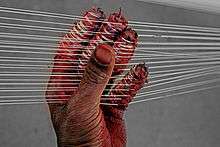Manja (kite)
Fighter kites in Afghanistan, Bangladesh, India, Nepal and Pakistan fly on abrasive string called manja (or manjha). In Brazil, similar string is called "cerol", and in Chile "hilo curado".

Kites are typically flown in specific seasons or festivals. All flyers will use coloured manja line, coated with powdered glass, and attempt to cut down opposing kites - which will drift away. Participants or bystanders often run after and try to capture such kites; a practice known as kite running.
Names
Abrasive cutting line for fighter kites is known under many local names:
- manjha – India, Bangladesh and Pakistan.
- tar – Afghanistan
- hilo de competencia – Chile
- hilo curado – Chile
- dore – India and Pakistan
- manjho – Rajasthan, India
- gelasan – Indonesia
- cerol – Brazil
Composition
Traditional manja is based on fine pure cotton thread coated with a mixture of rice glue, tree gums and similar natural ingredients - and an abrasive: finely powdered glass,[1] aluminum oxide or zirconia alumina. In some places individuals make their own manja from personal 'secret' recipes - but most is made by specialist craftsman on a large scale.
So-called "chemical manja" or "Chinese manja" is a relatively recent introduction. It is based on non biodegradable synthetic fibers.[2] This makes it harder to break, which can be seen as unsportsman-like, and makes the string more dangerous to bystanders and birds.
Safety and risks
There are a ranges of risk associated with flying fighter kites, many directly around the use of manja.
Tati
Fighters often fly the kites from rooftops, which poses risks to their safety.[3]
Kite runners
Kite runners gazing at the kite while following it often lose focus of their surroundings and they may run onto roads or train tracks without paying attention to oncoming traffic or trains.[4][5] They may also run risks by scaling trees and buildings in order to retrieve kites that land there, where they may fall as a result.
Bystanders being cut
Others are also at risk, with many reports of motorcyclists and others having their throats cut by manja - especially when driving through hanging strings.[6][7][8][9][10][11] These sorts of incidents have led to calls for bans of the sale of glass-coated kite string in many regions. The Chamber of Deputies of Chile enacted a law in 2013 forbidding the use of "hilo curado" by law, with the only exceptions being for professional kite flyers in secured locations for competitive use, using strings coated with silicon powder.[12] In 2010, one report said that the ban on Chinese manja in India did not work to curb its sale.[13]
Threat to birds
Manja is also dangerous to birds as kites that land in trees do not allow for the strings to break apart easily, frequently causing injuries that require their rescue.[14] A pair of volunteer bird medics in New Delhi care for about 1,000 black kites each year, 90% of which are injured by manja and half of which die.[15]
At the Uttarayan festival, veterinarians had to repeatedly respond to situations where birds had been injured.[16]
References
- Ghai, Rajat (15 December 2006). "Manja market flying low!". The Times of India. Archived from the original on 24 June 2015.
- Muvalia, Gaurav; Jamshed, Nayer; Sinha, Tej Prakash; Bhoi, Sanjeev (2019). "Kite-string injuries: A case series". International Journal of Critical Illness and Injury Science. 9 (3): 147–150. doi:10.4103/IJCIIS.IJCIIS_44_19. ISSN 2229-5151. PMC 6792401. PMID 31620355.
- TNN (16 January 2004). "Uttarayan cuts short six lives". The Times of India.
- Malik, Shahid (10 June 2003). "Pakistan tackles killer kites". BBC News. Lahore.
- "10-year-old boy dies chasing kite". The Times of India. 14 January 2008.
- "Kite thread claims girl's life, 73 others injured in Jaipur on Sankranti". The Hindu. 14 January 2014.
- "Two Children Die After Kite String Cut Throats". Sky News. Retrieved 17 August 2016.
- "India: Two children, man dead after sharp kite strings slit throats". CNN. Retrieved 21 August 2016.
- "Manja kite thread slits 40-yr-old techie throat in Chennai". The New Indian Express. 8 March 2017. Retrieved 7 May 2017.
- "Throat slit by manja, doctor lay bleeding on Pune road for 20 minutes". Hindustan Times. 10 October 2018. Retrieved 11 October 2018.
- "3 Dead After Kite Strings Slit Throats In Gujarat's Uttarayan Festival". NDTV. Press Trust of India. 15 January 2019. Retrieved 15 January 2019.
- Chamber of Deputies of Chile (18 February 2014). "En 2013 se publicó ley que sanciona comercialización del hilo curado" [In 2013, a law was published that sanctions the marketing of cured wire].
- Manish, Kumar (6 January 2010). "Banned Chinese manja still on sale". The Times of India.
- "Chinese manja injures nearly half a dozen birds since January 1". The Times of India. 6 January 2013.
- Whang, Oliver; Khandelwal, Saumya (7 February 2020). "Meet the Bird Medics of New Delhi". The New York Times. ISSN 0362-4331. Retrieved 21 February 2020.
- Sources:
- Sharma, Radha (5 January 2006). "Vets to heal birds this Uttarayan". The Times of India.
- "Vulture worries stalk activists on Uttarayan". The Times of India. 14 January 2007. Archived from the original on 19 October 2012.
- Sharma, Radha (10 January 2008). "Docs flock to save winged victims". The Times of India.
- "Soaring kites ground at least 600 winged souls". The Times of India. 15 January 2005.
- Nigam, Jhumari (12 January 2004). "Celebrate... but with compassion". The Times of India.
- "Many birds fall prey as kites rule skies". The Times of India. 15 January 2003.